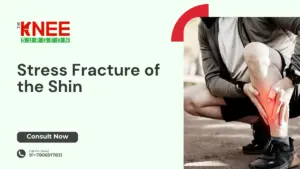You’ve been running, training, or staying active, when a dull pain begins to creep along your shin. At first, you might brush it off as soreness from exercise. But if the discomfort doesn’t fade and even starts to feel worse it could be more than simple muscle fatigue. Many active people, especially runners and athletes, experience a stress fracture of the shin. While the name may sound intimidating, the good news is that with the right care, most people make a full recovery and return to the activities they love.
In this article, we’ll walk through what a stress fracture is, how to recognize it, what causes it, how to treat it, and steps you can take to prevent it from coming back.
What is a Stress Fracture in the Shin?
A stress fracture of the shin is a tiny crack in the tibia, the long bone at the front of your lower leg. Unlike a major fracture, which usually happens from a single traumatic event, stress fractures develop gradually from repeated stress on the bone. Think of it as the bone becoming overwhelmed by tiny micro-injuries faster than it can repair itself. This is different from shin splints, which cause diffuse pain along the shin. A stress fracture tends to feel more localized like you can point with your finger to the painful spot.
Symptoms of a Stress Fracture in the Shin
Some of the most common signs include:
- Sharp or aching pain that worsens during exercise and eases with rest
- Swelling or tenderness over a specific point of the shin
- A visible or subtle stress fracture shin bruise near the painful area
- Pain that increases over time if activity continues
If ignored, a stress fracture of the shin may eventually cause discomfort even at rest, which signals the injury needs urgent attention.
Causes of Stress Fractures in the Shin
A stress fracture of the shin usually develops from a combination of training, lifestyle, and health factors. Some common causes are:
- Overuse: Rapidly increasing running mileage or intensity without enough rest
- Improper footwear: Worn-out or unsupportive shoes that don’t absorb impact well
- Hard training surfaces: Running on concrete or other unforgiving surfaces
- Bone health issues: Low vitamin D, calcium deficiency, or reduced bone density
- Biomechanics: Flat feet, high arches, or gait imbalances that increase shin stress
Types of Stress Fractures
Stress fractures aren’t all the same. They can vary in location and severity:
- Low-risk fractures: Typically heal well with rest and conservative management
- High-risk fractures: May occur in areas of the shin bone that don’t heal as easily and sometimes need closer monitoring or surgical support
- Transverse fractures: Run across the bone
- Longitudinal fractures: Run along the length of the bone
Your doctor will usually confirm the type with an X-ray or MRI, since early stress fracture of the shin injuries don’t always show up clearly on scans.
How are Stress Fractures in the Shin Treated?
The cornerstone of stress fracture in shin treatment is rest. Your bone needs time to heal, and continuing intense activity can worsen the injury. Treatment often includes:
- Activity modification: Switching from high-impact activities like running to lower-impact exercises such as swimming or cycling
- Immobilization: Wearing a protective boot or brace in more severe cases
- Pain relief: Ice, elevation, and sometimes anti-inflammatory medication
- Physical therapy: To strengthen supporting muscles and correct biomechanical issues
- Nutritional support: Ensuring adequate calcium, vitamin D, and overall balanced nutrition
In rare cases, surgery may be needed if a stress fracture of the shin doesn’t heal with conservative treatment.
Preventing Stress Fractures
The best approach is prevention, especially for athletes and active individuals. Here’s how you can reduce your risk:
- Increase training intensity gradually no sudden mileage jumps
- Use supportive footwear and replace worn-out shoes regularly
- Run on softer surfaces when possible
- Incorporate strength training for your legs, hips, and core
- Prioritize rest days and recovery in your training plan
- Maintain bone health with good nutrition and sunlight exposure for vitamin D
Taking these steps not only lowers the risk of a stress fracture of the shin, but also helps prevent other overuse injuries.
Results
Healing times vary, but most people can expect stress fracture shin recovery time to range from 6 to 12 weeks, depending on the severity of the fracture and how well they follow treatment advice. During this period, rest and patience are key. The long-term outlook is excellent. With proper stress fracture in shin treatment, most people recover fully, return to sports, and resume daily activities without limitations. If you notice persistent swelling, pain, or a lingering stress fracture shin bruise, it’s best to check in with your doctor to ensure healing is on track.epending on the severity of the fracture and how well they follow treatment advice. During this period, rest and patience are key.




